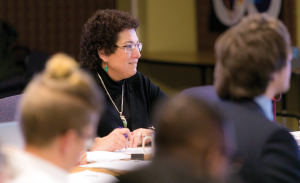
The original curriculum at what is now the Center for Justice and Peacebuilding (CJP) was created in 1995, shortly after the end of the Cold War. It was a time of hope and a time of worry. It seemed possible that the world might move resources from war systems to other pressing human needs. It seemed possible that residual violent conflicts – the proxy wars of the Cold War period – might be transformed. It seemed possible that focusing on inclusive decision-making, reconciling relationships, acknowledging and healing past harms and promoting a restorative approach to issues of justice could have real impact. At the same time, new wars were breaking out in the Balkans, and the existing ways of dealing with violent conflict seemed poorly suited to these new challenges.
The CJP curriculum, from the outset, embraced holistic and multi-faceted approaches to issues of promoting justice and reducing violence. Our faculty and graduates have achieved the early goals in some communities and in some countries. However, injustice and violence are like cancers or bacteria; they transform in order to thrive.
We need to regularly alter our understanding and our approaches if we want to have any chance of ending violence and transforming injustice.
CJP is comprised of uniquely knowledgeable people – faculty members are active practitioners and students arrive with direct experience of problems they want to better understand in order to take well-informed and realistic transformative actions. Consequently, the curriculum undergoes a major revision approximately every five years, largely as a response to changing world conditions.
When the program started, the general public and most academics were inclined to locate issues of conflict and violence “over there” in other countries. Today, it is clear to many that the United States is neither different from nor separated from “over there.” You can’t, for example, look at the challenge of conflict between communities of color and an increasingly militarized policing system and not see parallels to other countries with similar problems.
When the program started, most practitioners working to transform conflicts talked of conflict cases that could be managed. Today, it is apparent that many if not most of the manifestations of violence and injustice are the result of tightly intertwined systems that have failed to deliver just outcomes. If we want to talk about a “case” of conflict, we need to define the problem as larger than the parties who end up involved in direct conflict with one another. We need to consider the systems that have given rise to the conditions that support their open conflict.
This new understanding is illustrated in a case that we study in the new curriculum. Hurricane Katrina wiped out large sections of the metropolitan city of New Orleans in Louisiana in 2005 revealing huge problems of systemic racism, poverty, inequality and failed governance structures. As we unpack this case in class, it becomes clear that the harms of Hurricane Katrina are rooted in historical discriminatory housing policies, the legacies of slavery, systems of political corruption, the practice of locating human communities within fragile ecosystems, and a host of other systems created and sustained by humans. If we want to harvest justice and peace from this catastrophe, we need a multi-faceted and creative approach. Students analyze the many factors that created the conditions for Hurricane Katrina and they study a wide array of responses to the disaster with a focus on evaluating how well those responses have addressed underlying causes.
The Hurricane Katrina case is used in the second of two team-taught courses that integrate analysis, theory, and design thinking. Foundations of Justice and Peacebuilding I and II teach students to analyze complex problems of injustice, violence and harm; design creative responses; and think ahead to how those responses would be implemented and evaluated. The first course starts with less complex cases and the second course ends with large challenges such as transforming the systems that are driving global climate change.
The last piece of the new required core courses will be implemented this year with the introduction of Research Methods for Social Change. This course ties research to problems of action and prepares students to learn continuously about the problems they are addressing and the effectiveness (or not) of their own work.
All is not new at CJP, however. We have retained and improved distinctive features of our curriculum.
The long-standing promotion of reflective practice at CJP has been refined into a curriculum that emphasizes personal formation. Our goal is to promote self-awareness and skills of self-management so that our graduates can remain calm and focused when faced with situations of great ambiguity. We also prepare graduates to work in teams by providing a coaching support system for their first major team project.
And, as always, we continue to require the mastery of specific skills for managing conflict and promoting justice. As you’ll read in the following pages, students learn, grow and prepare for the future through practice and practicum experiences, and strong mentorship by Amy Knorr, our peacebuilding practice director and faculty members.
The learning objectives for the students are under constant scrutiny and revision. The process of updating the curriculum is discussed with the students who, consequently, embrace a continuous learning approach to their own work. This is one reason they are seen as leaders in the field.